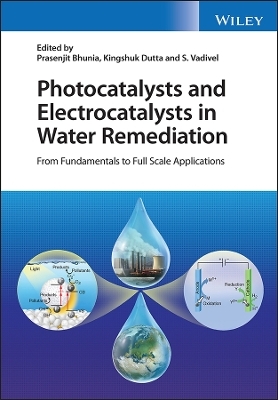
Photocatalysts and Electrocatalysts in Water Remediation
John Wiley & Sons Inc (Verlag)
978-1-119-85531-6 (ISBN)
Photocatalysts and Electrocatalysts in Water Remediation introduces the fundamentals of both photo- and electro-catalysts and highlights the potentials of photo- and electro-catalysis towards water decontamination, covering strategies to improve photo- and electro-catalytic efficacies, functions of photo- and electro-catalysts and involved chemical reactions, and challenges and recent developments in the field, with additional discussion of both lab-scale and commercial-scale materials and processes.
As a forward-thinking resource, the text also discusses the scope of further research on photo-, electro- and electrophoto-catalysts. Edited by three highly qualified professionals, with significant experience in the field, the text is further enriched with critically analyzed and expertly opined contributions from several well-known researchers around the world.
In Photocatalysts and Electrocatalysts in Water Remediation, readers can expect to find information on:
Fundamentals and functional mechanisms of photocatalysis in water treatment, and different synthetic routes and band gap engineering of photocatalysts
Photocatalytic decontamination of organic pollutants from water and photocatalytic removal of heavy metal ions from water
Smart photocatalysts in water remediation
Fundamentals and functional mechanisms of electrocatalysis in water treatment
Electrocatalytic degradation of organic pollutants and removal of heavy metal ions from water
Different synthetic routes of electrocatalysts and fabrication of electrodes and combined electro-photocatalytic techniques in water remediation
Photocatalysts and Electrocatalysts in Water Remediation serves as one of the most comprehensive and authoritative resources that has ever been published in this field and is a thoroughly complete source of information on the subject for researchers across a myriad of disciplines along with water industry professionals.
Dr Prasenjit Bhunia is an Assistant Professor in the Department of Chemistry, Silda Chandra Sekhar College (affiliated to Vidyasagar University), West Bengal, India. Dr Kingshuk Dutta, FICS, is a Scientist in the Advanced Polymer Design and Development Research Laboratory of the Central Institute of Petrochemicals Engineering and Technology, Karnataka, India. Dr S. Vadivel is an Assistant Professor (Senior Grade) in the Department of Electrochemistry, Saveetha School of Engineering, Saveetha Institute of Medical and Technical Sciences, Tamil Nadu, India.
Preface ix
About the Editors xi
List of Contributors xiii
Acknowledgements xv
1 Fundamentals and Functional Mechanisms of Photocatalysis in Water Treatment 1
1.1 Introduction 1
1.2 Different Photocatalytic Materials for Water Treatment 2
1.3 In-depth Mechanisms of Photocatalysis 9
1.4 Visible Light Driven Photocatalysts for Water Decontamination 20
1.5 Summary 25
2 Different Synthetic Routes and Band Gap Engineering of Photocatalysts 39
2.1 Introduction 39
2.2 Synthesis of Photocatalysts 40
2.3 Properties of Ideal Photocatalytic Material 57
2.4 Engineering Photocatalytic Properties 58
2.5 Energy Bandgap 59
2.6 Engineering the Desired Band Gap 64
2.7 Photocatalytic Mechanisms, Schemes and Systems 69
2.8 Summary and Perspectives 71
3 Photocatalytic Decontamination of Organic Pollutants from Water 81
3.1 Introduction 81
3.2 Photocatalytic Degradation Mechanisms of Organic Contaminants 82
3.3 Advanced Photocatalytic Materials for Decontamination of Organic Pollutants 83
3.4 Solar/Visible-light Driven Photocatalytic Decontamination of Organic Pollutants 85
3.5 Emerging Scientific Opportunities of Photocatalysts in Removal of Organic Pollutants 87
3.6 Limitations of Photocatalytic Decontamination and Key Mitigation Strategies 95
3.7 Summary and Future Directions 96
4 Photocatalytic Removal of Heavy Metal Ions from Water 105
4.1 Introduction 105
4.2 Mechanistic Insights on Photocatalytic Removal of Heavy Metal Ions 110
4.3 Solar/Visible-light Driven Photocatalysts for the Removal of Heavy Metal Ions 113
4.4 Selective Heavy Metal Ion Removal by Semiconductor Photocatalysts 123
4.5 Major Drawbacks and Key Mitigation Strategies 125
4.6 Summary and Future Directions 126
5 Smart Photocatalysts in Water Remediation 135
5.1 Introduction 135
5.2 Advances in the Development of Visible-light Driven Photocatalysts 138
5.3 Advances in Photocatalyst Immobilization and Supports 142
5.4 Advances in Nonimmobilized Smart Photocatalysts 144
5.5 Advances in Improving the Efficiency of Light Delivery 149
5.6 Advances in Biomaterials for Designing Smart Photocatalysts 157
5.7 Advances Toward Improving Photocatalytic Activity via External Stimuli 159
5.8 Advances in Inhibiting the Photocorrosion of Semiconductor-based Photocatalysts 164
5.9 Advances in Recycling Photocatalysts: Assessing the Photocatalyst Life Cycle 166
5.10 Summary, Future Challenges, and Prospects for Further Research 167
6 Fundamentals and Functional Mechanisms of Electrocatalysis in Water Treatment 189
6.1 Introduction 189
6.2 Electrocatalysis Treatment 190
6.3 Properties and Characteristics of Different Electrocatalysis Techniques 192
6.4 Case Studies and Successful Approaches 202
6.5 Conclusion 217
7 Different Synthetic Routes of Electrocatalysts and Fabrication of Electrodes 229
7.1 Introduction 229
7.2 Fundamental Principles of Alkaline Water Oxidation 230
7.3 Electrochemical Evaluating Parameters of Electrocatalysts for OER Performance 231
7.4 Electrocoagulation 233
7.5 Electroflotation 233
7.6 Electrocoagulation/flotation 233
7.7 Electro-oxidation in Wastewater Treatment 233
7.8 Doped Diamond Electrodes 234
7.9 Conclusion 235
8 Electrocatalytic Degradation of Organic Pollutants from Water 241
8.1 Introduction 241
8.2 Principles and Fundamental Aspects of Electrooxidation 242
8.3 Electrode Materials and Cell Configuration 244
8.4 Performance Assessment Indicators and Operating Variables 250
8.5 Electrochemical Filtering Process: A Hybrid Process Based on Electrooxidation and Filtering 253
8.6 Integration of Electrooxidation-based Processes in Water/Wastewater Treatment Technological Flow 259
9 Electrocatalytic Removal of Heavy Metal Ions from Water 275
9.1 Introduction 275
9.2 Fundamentals 277
9.3 Advantages and Disadvantages of the Electrocatalytic Approach 283
9.4 Summary 284
10 Combined Photoelectrocatalytic Techniques in Water Remediation 289
10.1 Introduction 289
10.2 Photoelectrocatalysts for Treatment of Water Contaminants 292
10.3 Simultaneous Removal of Organic and Inorganic Pollutants 302
10.4 Conclusions and Perspective 304
Index 311
| Erscheinungsdatum | 20.01.2023 |
|---|---|
| Verlagsort | New York |
| Sprache | englisch |
| Maße | 170 x 244 mm |
| Gewicht | 709 g |
| Themenwelt | Naturwissenschaften ► Chemie ► Organische Chemie |
| Technik ► Bauwesen | |
| ISBN-10 | 1-119-85531-4 / 1119855314 |
| ISBN-13 | 978-1-119-85531-6 / 9781119855316 |
| Zustand | Neuware |
| Informationen gemäß Produktsicherheitsverordnung (GPSR) | |
| Haben Sie eine Frage zum Produkt? |
aus dem Bereich



